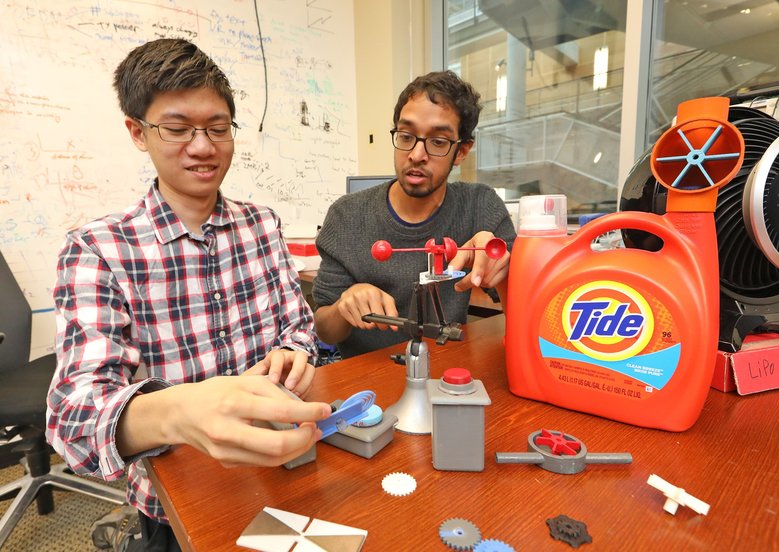By Catherine Long
The Seattle Times
WWR Article Summary (tl;dr) A team of graduate students and faculty at the University of Washington is looking for low-power (or no-power) ways to enhance communication with household objects.
SEATTLE
You don’t have to ask Alexa, or even push a button. With new devices pioneered by a University of Washington computer science team, battery-less objects made entirely of plastic could communicate with other devices on your home network.
For example, a laundry detergent bottle could monitor your detergent use for you, and order more when you’re running low.
And you could print or design similar objects yourself, using a standard 3-D printer.
The new concept is the latest idea to come out of the Allen School’s Networks and Mobile Systems Lab at UW, a team of graduate students and faculty looking for low-power (or no-power) ways to enhance communication with those household objects that are commonly known as the internet of things.
The same team also has created a battery-free cellphone that uses almost no power and never needs to be charged. And they created a “singing poster” that could broadcast a song to somebody standing nearby by piggybacking onto FM radio waves.
The lab is throwing its newest concept out to the wider world, hoping an army of tinkerers and do-it-yourselfers, or “makers,” will fire up their 3-D printers and their imaginations, and figure out cool things to do with the technology.
With the plans available online, “it really empowers people to make things that are custom-made for their needs,” said Shyam Gollakota, associate professor in the Paul G. Allen School of Computer Science & Engineering. He directs the Networks and Mobile Systems Lab, which employs six doctoral students
The 3-D printed objects use plastic gears, springs and switches to create mechanical movement, like an old-fashioned windup watch. That movement allows the devices to communicate via Wi-Fi, taking advantage of the router in your house or office that’s constantly broadcasting a radio signal.
As the gears and springs move within the plastic device, because you’ve pushed a button, or poured a liquid that causes the gears to spin, they cause a conductive metal switch to intermittently connect and disconnect to the device’s metal antenna, said UW electrical engineering graduate student Vikram Iyer.
The antenna’s signal is reflected by the radio waves broadcast by your Wi-Fi router. When the switch is toggled on and off, the antenna either reflects or absorbs radio waves broadcast by your router.
Computer science grad student Justin Chan gives this analogy: Your home Wi-Fi router is constantly blasting out radio waves in the same way that a really bright flashlight blasts out light.
The 3-D plastic objects these students have created are like mirrors that reflect or deflect that bright light, using the antenna to send a message to a receiver, a smartphone, that could be decoded by software.
To prove how this might work, the UW students made a couple of simple devices that use gears to measure movement.
There’s a device that snaps onto the top of a bottle of liquid laundry detergent, for example, with gears that move as the detergent is poured out of the bottle. (Everything is printed with a 3-D printer, even the antenna and switch, which are made using a plastic-and-copper filament that’s readily available on the 3-D printer market.)
The device can measure how much has been poured out so far, which could help you know when it’s time to order more, or it could even order more detergent for you automatically.
Another device measures wind speed using gears and springs, sending the information through the Wi-Fi stream. The team also has created switches and sliders that could be used to control the volume of a stereo, or turn on a light, without using battery power that remote-control devices all require.
Still on their to-do list: Designing an app that could interpret the Wi-Fi signals, although Iyer said that’s not difficult.
The 3-D Wi-Fi research was funded by the National Science Foundation, the Alfred P. Sloan Fellowship and Google.
Gollakota’s lab works on themes of wireless communication and sensing. Iyer said the group has brainstorming sessions that go on for hours. They take a question that seems almost unsolvable, something that would seem to need magic for it to work, and try to figure out a way to solve it.
In this case, the question was: How can we create 3-D plastic objects that can communicate, without Wi-Fi chips or electronics?
The lab has developed a mobile phone prototype app that can detect whether somebody has sleep apnea; that technology has been licensed to a company that is developing it further.
They also have invented clothing that has identification information woven into the fabric, allowing an employee to breeze through a door just by holding a sleeve up to a sensor, without having to pull out a security badge.
Several alumni of the lab have spun out a company, Jeeva Wireless, that is exploring ways to use low-energy devices for communication. The initial prototypes for some of Jeeva’s core technologies were developed in the UW’s computer science labs.
“There are definitely a lot of very cool things happening,” Chan said.
___
(c)2017 The Seattle Times
Visit The Seattle Times at www.seattletimes.com
Distributed by Tribune Content Agency, LLC.
_____
PHOTO (for help with images, contact 312-222-4194): SCI-PLASTIC-WIRELESS














































































































































































































































































































































































